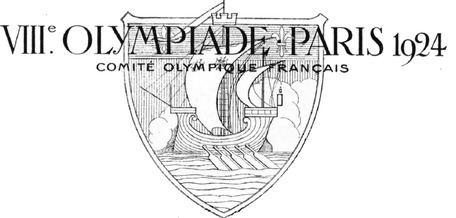The 1924 Summer Olympics (French: Les Jeux olympiques d'été de 1924), officially known as the Games of the VIII Olympiad, were an international multi-sport event which was celebrated in 1924 in Paris, France. It was the second time Paris hosted the games, after 1900. The selection process for the 1924 Summer Olympics consisted of six bids, and Paris was selected ahead of Amsterdam, Barcelona, Los Angeles, Prague, and Rome. The selection was made at the 20th IOC Session in Lausanne in 1921.
The cost of the Games of the VIII Olympiad was estimated to be 10,000,000₣. With total receipts at 5,496,610₣, the Olympics resulted in a hefty loss despite crowds that reached 60,000 people at a time.
The opening ceremony and several sporting events took place in the Olympic Stadium of Colombes, which had a capacity of 45,000 in 1924.This VIII Olympiad was the last one organised under the presidency of Pierre de Coubertin.The "Flying Finns" dominated the long distance running, while the British and Americans dominated the shorter events. Paavo Nurmi won the 1500 m and 5,000 m (which were held with only an hour between them) and the cross country run. Ville Ritola won the 10,000 m and the 3,000 m steeplechase, while finishing second to Nurmi on the 5,000 m and cross country. Albin Stenroos won the marathon, while the Finnish team (with Nurmi and Ritola) was victorious in the 3,000 m and cross country team events.British runners Harold Abrahams and Eric Liddell won the 100 m and 400 m events, respectively. Their stories are depicted in the 1981 movie Chariots of Fire. In addition, Douglas Lowe won the 800 m competition.The marathon distance was fixed at 42.195 km (26.219 mi), from the distance run at the 1908 Summer Olympics in London.The 1924 Olympics were the first to use the standard 50 m pool with marked lanes.Swimmer Johnny Weissmuller won three gold medals in swimming and one bronze in water polo.Harold Osborn won gold medals and set Olympic records in both the high jump and the decathlon at the 1924 Olympics. His 6' 6" high jump remained the Olympic record for 12 years, while his decathlon score of 7,710.775 points also set a world record and resulted in worldwide press coverage calling him the "world’s greatest athlete".Fencer Roger Ducret of France won five medals, of which three were gold.In gymnastics, 24 men scored a perfect 10. Twenty-three of them scored it in the now-discontinued event of rope climbing. Albert Seguin scored a 10 here and also a perfect 10 on side vault.Unexpectedly, the national team of Uruguay won the gold medal in football.The Olympic motto Citius, Altius, Fortius (Faster, Higher, Stronger) was used for the first time at the Olympics. It had been used before by the Union des Sociétés Françaises de Sports Athlétiques, a French sporting federation whose founding members included Pierre de Coubertin. De Coubertin took the motto from his friend Henri Didon, a Dominican priest who had coined during a speech before a Paris youth gathering of 1891.Ireland was given formal recognition as an independent nation in the Olympic Movement in Paris in 1924, and it was at these games that Ireland made its first appearance in an Olympic Games as an independent nation.Originally called Semaine des Sports d'Hiver ("Week of Winter Sports") and held in association with the 1924 Summer Olympics, the sports competitions held in Chamonix between 25 January and 5 February 1924 were later designated by the International Olympic Committee (IOC) as the I Olympic Winter Games. (1924 Winter Olympics)These were the first Games to feature an Olympic Village.The Art competitions at the 1924 Summer Olympics were the first time that the Olympic Art competitions were contested seriously, with 193 entries in five categories. A total of 14 medals were awarded, though none were given in the music category.126 events in 23 disciplines, comprising 17 sports, were part of the Olympic program in 1924. The number of events in each discipline is noted in parentheses.
Basque pelotaCanoeingJeu de paumeLa canneSavateVolleyballBaseballSeventeen sports venues were used in the 1924 Summer Olympics. Stade de Colombes served as the final venue for the 1938 FIFA World Cup between Italy and Hungary.
A total of 44 nations were represented at the 1924 Games. Germany was still absent, having not been invited by the Organizing Committee. China (although did not compete), Ecuador, Haiti, Ireland, Lithuania, and Uruguay attended the Olympic Games for the first time while the Philippines competed for first time in an Olympic Games as a nation though it first participated in 1900 Summer Olympic Games also in this city. Latvia and Poland attended the Summer Olympic Games for the first time (having both appeared earlier at the 1924 Winter Olympics in Chamonix).
China, also took part in the Opening Ceremony, but its four athletes (all tennis players) withdrew from competition.These are the top ten nations that won medals the 1924 Games.
Pierre de Coubertin—founder of the IOC & father of the modern Olympics movement—personally awarded 21 Gold medals to members of the 1922 British Mount Everest Expedition including 12 Britons, 7 Indians, 1 Australian and 1 Nepalese.The last surviving competitor of the 1924 Summer Olympics was Croatian swimmer Ivo Pavelić, who died on 22 February 2011 at the age of 103.

